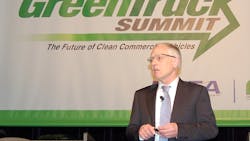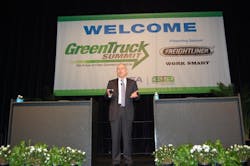A time of change: How will the future of trucking look?
INDIANAPOLIS. Wilfried Achenbach, senior vice president of engineering and technology for Daimler Trucks North America (DTNA), says we are living in a time of change – better yet, a time in which the trucking industry is changing at an extremely rapid pace. Achenbach delivered Tuesday’s keynote address here at the 2017 National Truck Equipment Association (NTEA) Work Truck Show’s Green Truck Summit and touched on what he believes the future of the industry will look like.
“Sometimes, I think, or it seems like Silicon Valley is taking over our industry for the good or the bad,” he noted. “Does it mean our industry will become more and more electronic? Without trucks our economy would not function – it would not be operational. Without trucks, the machine — our economy — would stall.”
Looking ahead to the next decade or so, Achenbach touched on three major contributing factors: connectivity, active safety and autonomous driving, and propulsion technology and powertrains options for the next 10-13 years.
Connectivity
Referring to it as the “data wave” — or Big Data — Achenbach told attendees it’s already here, and it’s here to stay. He explained the need to analyze operational data, including fuel economy recordings, and reports from safety systems and truck behavior. He also noted that remotely updating truck software will be the near future and that more information about predictive powertrain maintenance and repair will abound.
“When it comes to connectivity, we will see more displace,” he said. “Information has to be readily displayed to the driver so he can manage the complexity of the future truck. This is going to change. Here we have to watch where the car industry is going because many of those elements will be taken over from the cars.”
Achenbach also mentioned enhanced cyber security measures must be taken to prevent breaches. “We have to ensure nobody can take over a truck remotely,” he explained. “Like connectivity, it comes with it, and will stay with it, too.”
Active safety and autonomous driving
When it comes to active safety and autonomous vehicles, Achenbach said the future will hold better map data, higher resolution GPS, and more active cameras and sensors on trucks to enable 360-degree views.But will trucks really be able to drive on their own – without a driver? For that to happen, he believes significant improvements in infrastructure – vehicle-to-vehicle communication and vehicle-to-infrastructure communication – are needed. He also noted the importance of technical systems measuring up to the comparison of what a human driver and human brain system can do.
“For a technical system, this will be a little bit of a challenge for the near future,” he explained. “When it comes to accidents who is right? Who is wrong? This needs to be figured out. As a society, we need to accept that we will have mixed traffic with autonomous vehicles and human-operated vehicles.”
“I’m pretty certain we are on a path to more autonomous vehicles,” he added. “It will not come over night. We need a step-by-step approach.”
Achenbach said he believes it is feasible that we will see partially autonomous vehicles with a driver still in the seat in the near future. But he said he expects a much longer timeline for the emergence of fully autonomous, driverless vehicles.
Propulsion technology – powertrains
“Currently our workhorse is the diesel engine,” Achenbach explained. “We benefit here from a very high density of diesel. It’s easy to refill it and readily available. But everybody here knows it comes with two negative things that I call the diesel emission challenge: NOx, PM [particulate matter] and GHG [greenhouse gas], CO2 emissions.”
Since 1988, he noted that NOx and PM emissions have dropped significantly. For instance, one truck in 1988 essentially emitted as much NOx as the equivalent of 35 trucks today – up that to the equivalent of 60 trucks today for PM emissions.
The second part of the emissions story is GHG and CO2. According to Achenbach, trucks contribute 6% of CO2 emissions in the U.S., while industry contributes 27%, buildings contribute 39%, and overall transport contributes 34%. The trucking industry’s biggest contributor of CO2 by segment is line-haul, heavy-duty trucks.“In the U.S. if you want to reduce CO2, you need to take care of heavy duty and line-haul,” he said. “That’s where the meat is.”
Achenbach noted the progress heavy-duty engines made during the first phase of the GHG regulations, and mentioned stringent Phase 2 goals for 2021, 2024 and 2027. He added that the steady path starting in 2014 to obtain 10 MPG will be the new normal for tractor-trailer combinations in the foreseeable future. In order to obtain 10 miles per gallon, he said the industry must continue working on aerodynamic drag, rolling resistance and tire pressure.
When it comes to solving our problems regarding GHG emissions, Achenbach stressed that propulsion options of liquid and compressed natural gas will not do the trick. Biofuels, however, will. But making trucks work with electricity will take a high initial investment and more time.
“Two-thirds of our energy production is still based on using fossil fuels,” he emphasized. “To switch to solar, it’s a major undertaking. It takes a political bill and costs a lot of money. Currently, it doesn’t make any sense to go electric. It makes sense if we convert to solar and other energy investments, but it takes a major investment and political commitments.”
In addition, Achenbach noted that high voltage battery packs, which are the key element for an eDrive system, cost significantly more than diesel.
“Very honestly there is no simple answer,” he explained. “eDrive only makes sense if we are able to convert a high amount of our electric systems. It will take time, energy, cost and will take a significant commitment.”
“With diesel, we know the challenges,” he added. “I would not discount the diesel right now. I would really recommend looking into renewables. If you want to solve the environmental GHG issue, waste and renewables will be what to consider.
And when it comes to the new Trump administration and its thoughts on climate change and GHG regulations, Achenbach said he’s not too concerned.
“The industry will continue to seek improvements,” he stressed. “We will see in the next 10 years major improvements. If we see a change in regulations, we will certainly be able to adapt. I am not afraid of that.”
About the Author

Cristina Commendatore
Cristina Commendatore is a past FleetOwner editor-in-chief. She wrote for the publication from 2015 to 2023.


